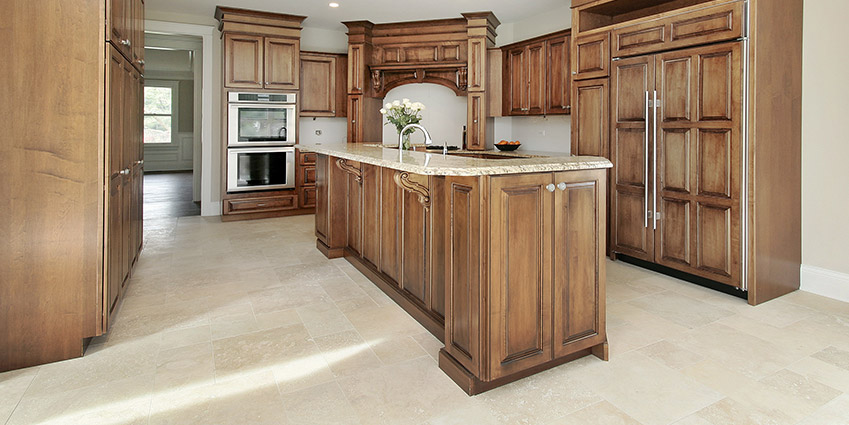There are so many options for choosing a kitchen floor, how can you tell which one is best when selecting a new one for your kitchen renovation project? First you have to eliminate a little guesswork. Take into account how much you cook. Look at the floor plan of your family’s kitchen. Does your family use the kitchen for just family dinners, or do you entertain friends and other guests as well?
Hardwood Floors
You could just go with hardwood floors. After all, the timeless look means your kitchen won’t look dated over the years beyond the completion of your renovation. Hardwood floors are relatively low-maintenance and really durable.
When cared for properly, they resist moisture and hold up to a lot of foot traffic and other abuse in a busy kitchen. However hardwood floors work best when your family’s kitchen has an open floor plan that allows long strips of wood to be laid out in neat rows evenly spaced across the length of the room.
Vinyl Floors
Vinyl flooring is another good option. It is ideal in kitchens where a lot of cooking takes place, but your budget does not allow for hardwood floors. Vinyl is super easy to clean, and it is also waterproof and does a bang up job at resisting stains.
Vinyl comes in a wide range of colors and patterns to match your décor, but be sure to choose something that won’t become dated over time or you may find yourself wanting to update sooner than later. Otherwise it is the perfect choice for low to mid-range kitchen renovation budgets.
Sheet vinyl is actually classified as a group of kitchen floor materials referred to as resilient flooring. This means it is a softer flooring option. The softness of the vinyl can help cushion your feet and ease back pain and muscle fatigue gained from standing on a hardwood floor for too long.
Porcelain Tile
Porcelain tile flooring is more durable than ceramic tile. Fired at extremely high temperatures, the porcelain is extremely hard, is impervious to stains, and resists moisture. If you have ever had a dishwasher leak out onto your floor, then you understand how important this seemingly small detail could be.
Porcelain tile can take such a beating that it is the preferred flooring for outdoor kitchens, dining areas, and patios. You can ask that a glassy coating be put on your glazed tiles that tint them any color that you want. As with vinyl, you will want to make choices that encourage timelessness to avoid redoing them in a few years.
Unglazed tile takes on the tint of whatever clay was used to make them. This gives them natural, stone-like tones and may even mimic the look of actual stone, but at a much, much lower cost than trying to outfit your family’s kitchen with real stone during a renovation project. Make sure your tile choice is one that the Americans with Disabilities act has certified as being slip-resistant.
Eco-Friendly Choices
Unlike hardwood floors, which come from hardwood forests, there are options that are a better choice for the environment. For example, you might choose cork flooring. Cork is softer, like vinyl, but is made without the chemicals used to create sheet vinyl flooring, such as what is used in a kitchen remodeling job.
The bark harvested to create cork flooring regrows every decade or so, making it super sustainable and allowing for several repeated harvestings. The countries where these trees grow carefully regulate to make sure the vegetation will not get wiped clean through overharvesting.
Due to its individual cell structure, cork is both compressible and waterproof. Not only is it comfortable to walk on, but it also resists moisture so you won’t have to worry about mold or mildew forming. Whether you get 12” square tiles or long planks of cork wood, each one has an artsy, unique pattern of speckles and swirls.
All the Benefits of Bamboo Floors for the Kitchen
Another option is bamboo flooring. Bamboo flooring retains the look and durability of hardwood, along with the feeling and style of timelessness that you want in your family’s new kitchen floor. However, like the trees used to harvest cork, bamboo grows at extremely fast rates.
Because bamboo forests grow at such extremely fast rates, they are super sustainable, replenishing themselves much quicker than a hardwood forest would after being harvested. Bamboo floors may cost you a little more than other kitchen flooring choices, but when you consider that they will outlast other flooring materials it is a good investment when replacing the floor in your kitchen during a remodeling or renovation project.


